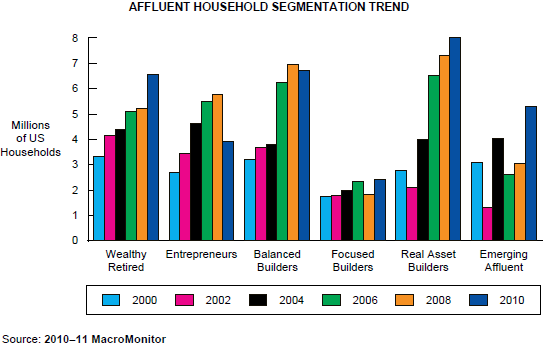Ah-Ha! Tomorrow's Wealthy Will Come from Today's Emerging Affluent MacroMonitor Marketing Report May 2011
About this Report
At a time when many financial-services providers are competing for qualified affluent customers, the ability to identify and understand Emerging Affluent households better could prove to be particularly profitable. Consumer Financial Decisions has designed an affluent segmentation to enable financial-services providers to market more effectively to desirable Emerging Affluent households.
Emerging Affluent households represent a promising opportunity for financial-services providers for the following reasons:
- A ten-year trend shows segment growth from roughly 3 million households in 2000 to 5.3 million households in 2010.
- Emerging Affluent households represent an up-and-coming segment whose increasing wealth and fluid loyalties might be easier to capture than those of more established affluent groups.
- Although the Emerging Affluent may represent only marginal short-term profits, they represent the largest net present value in the long term.
- In these times of institutional consolidation and product convergence, Emerging Affluent households are more likely than not to stay with existing providers as their wealth increases and their financial needs become broader.

As the youngest of the affluent groups, Emerging Affluent households currently have relatively few investible assets. Consequently, these households are often below the radar of most institutions that target the affluent. Although some institutions may believe that they can wait until the Emerging Affluent accumulate more wealth, this strategy in the New Normal (post 2008 recession) may prove to be a mistake.
This report sheds some light on how Emerging Affluent households are similar to and different from Other Affluent households. The following are several highlights from this report:
- The Emerging Affluent are solid, upper-middle-class households. As such, they are in a somewhat precarious position in today's society. A reversal of fortune, such as a job loss or a major medical emergency, could quickly cause their household to slip back to mass-market status.
- Because they are exceptionally busy, nearly three in five Emerging Affluent households say they prefer to spend as little time making investment decisions as possible.
- The key to attracting Emerging Affluent households is to understand—better than your competition does—their goals and purposes for borrowing and the topics about which they would like to learn more. Financial-services providers that use this understanding to attract, initiate, or expand a relationship with Emerging Affluent households will secure a reliable source of profits for the foreseeable future.
The use of findings from this report can help you fine-tune your marketing efforts to Emerging Affluent households. Through a strategic partnership with Information Asset Partners (IAP), you can locate Emerging Affluent households in your customer database, your prospect list, or your market footprint.
Table of Contents
| Executive Summary | 1 |
| The Emerging Affluent: Definition | 2 |
| Who the Emerging Affluent Are | 4 |
| Balance Sheet | 6 |
| Products, Services, and Accounts | 9 |
| Channel | 12 |
| Plans for the Future | 14 |
| Institutions | 16 |
| Information, Advice, and Advisors | 20 |
| Conclusions | 25 |
| Tables | |
| Demographics | 4 |
| General Attitudes | 5 |
| Liabilities | 7 |
| Credit Attitudes | 7 |
| Life Insurance Attitudes | 8 |
| Assets | 9 |
| Account Ownership | 10 |
| General Investment Attitudes | 10 |
| Financial-Product Use | 11 |
| Delivery Channels | 12 |
| Financial Transactions Attitudes | 13 |
| Spending Attitudes | 14 |
| Confidence Attitudes | 18 |
| Service Attitudes | 21 |
| Information and Advice Attitudes | 22 |
| Savings Goals | 23 |
| Purposes for Borrowing | 23 |
| Retirement Attitudes | 23 |
| Figures | |
| Affluent Household Segmentation | 2 |
| Affluent Household Segmentation Trend | 3 |
| Net Worth and Other Calculated Variables | 6 |
| Wills, Powers of Attorney, and Estate Executor | 15 |
| Financial Institution Use | 16 |
| Assets by Institution | 17 |
| Have "A Great Deal" of Trust in Institutions | 19 |
| Have "A Great Deal" of Trust in Intermediaries | 20 |
| Who Has Financial Control versus Financial-Control Preference | 21 |
| Interest in Learning More about Financial Topics | 24 |